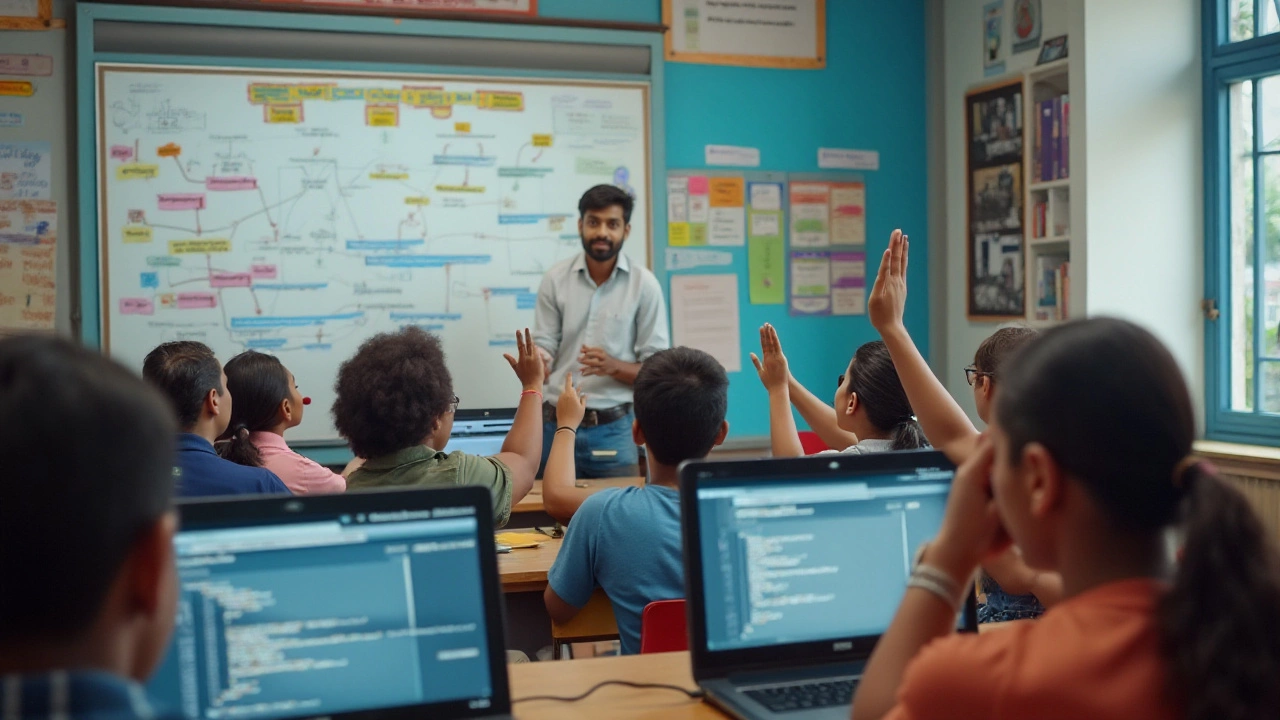Diving into the world of programming can be both exciting and daunting. The question on many minds is just how fast one can grasp the basics of coding. While some may claim to pick up new programming languages in days, the reality is influenced by many factors, including your background, learning style, and the time you're willing to invest.
The first step to coding effectively is setting clear and achievable goals. Knowing what you want to build or solve helps in staying motivated and choosing the right path. From there, motivation plays a crucial role. The passion and consistency you bring to your learning process can significantly speed up your progress.
Choosing the right resources is also key. Whether online courses, coding boot camps, or self-taught methods, each has its advantages. It's about finding what fits your style and schedule. We’ll explore these options and provide practical tips to help you learn coding faster than you might expect.
- Factors Influencing Learning Speed
- Setting Achievable Goals
- The Role of Motivation
- Choosing the Right Resources
- Practical Tips for Faster Learning
- Setting Realistic Expectations
Factors Influencing Learning Speed
When it comes to picking up a new skill, especially something as multifaceted as coding, several elements can affect how swiftly you progress. Let's delve into these factors to give you a better understanding of your potential learning curve. First and foremost, your motivation and interest play an unparalleled role. If you're genuinely passionate about becoming a coder, you'll naturally spend more time tinkering with code and seeking solutions to problems. This intrinsic drive often sets faster learners apart from those who struggle. Challenge yourself by setting small, manageable goals and celebrate when you achieve them. This method helps to keep the momentum and enthusiasm high.
Your background and prior experience also matter significantly. Those with a background in mathematics or problem-solving might find it easier to grasp programming concepts. This is because coding often requires logical thinking and identifying patterns. If you're stepping into coding from a completely different field, it might initially take longer to adjust, but don't lose heart. As you become more accustomed to the processes and terminologies, your pace will naturally pick up. Remember, everyone starts somewhere, and every expert was once a beginner.
The availability and quality of resources can expedite or hinder your learning journey. In today's digital era, there is a plethora of resources available, from online coding platforms to interactive coding classes. For instance, platforms like Codecademy or Coursera offer structured courses that can reinforce learning through practical exercises. If traditional classroom settings aren't your style, these online resources can offer a flexible learning schedule while maintaining a structured path for your educational journey.
An often-overlooked factor is the impact of a supportive learning environment. Collaborating with others can significantly hasten the learning process. Joining a community of like-minded learners can provide support when you're stuck, and there's always a benefit to seeing how others solve the same problems differently. Whether it's through coding forums, social media groups, or even local meetups, connecting with others can open new perspectives and teach you new tricks that you might not learn from an isolated study.
Finally, the research by Coding Dojo suggests that a structured, time-bound approach to learning can dramatically influence outcomes. According to their findings, people committing to a schedule of at least 10 hours per week can greatly enhance their learning speed compared to those who study sporadically. So, whether you're attending coding classes or learning independently, creating a consistent schedule and sticking to it can help solidify your newfound skills more effectively.
Setting Achievable Goals
When you decide to embark on the journey of learning to code, it's crucial to set goals that are not only ambitious but also achievable. This step is often overlooked, leading learners to drift without a clear direction. The key to success in this realm is specificity. Instead of vaguely aiming to 'learn to code,' pinpoint a specific goal — like building a website, automating a personal task, or contributing to open-source projects. The clearer the target, the more focused your efforts will be. Goals should be broken down into smaller, manageable milestones that act as stepping stones to the larger objective. For instance, if your goal is to create a web application, begin by mastering HTML and CSS, then slowly progress to JavaScript and backend technologies.
One practical way to set these milestones is by aligning them with coding classes or structured online courses. These offer a roadmap that inherently breaks down the process into digestible chunks. Esther Derby, an acclaimed software coach, once said,
"Small, achievable goals are like torchlight on a dark path; they make the journey less daunting."By setting these incremental goals, you give yourself the power to celebrate small wins, keeping the motivation alive.
To make your goals more tangible, consider using the SMART criteria — goals that are Specific, Measurable, Achievable, Relevant, and Time-bound. For instance, instead of saying, "I want to learn Python," a SMART goal would be, "I will complete the Python for Beginners course within four weeks." The timeframe pushes you to stay on track, while the specificity helps measure your progress. Moreover, take into account your personal life, commitments, and learning pace while setting these timelines to avoid burnout. Regularly revisiting and adjusting these goals is equally important as it keeps them realistic and aligned with your evolving understanding and skills.
The practice of writing down your goals and reviewing them frequently can not be overstated. Recent studies suggest that individuals who write down their goals are 42% more likely to achieve them. This habit not only reinforces your commitment but also acts as a constant reminder of why you started. Additionally, sharing your goals with peers or mentors can further boost accountability, adding a layer of support to your learning process.
If you feel stuck or overwhelmed at any point, remember that it’s perfectly okay to recalibrate. Often, initial goals might seem appealing but may need tweaking as you delve deeper into the coding universe. Embrace flexibility as learning to code is as much about the journey as it is about the destination. Celebrating your progress, no matter how small, plays a vital role. It motivates you to push harder and climb the next rung on the coding ladder. With clearly set goals, every lesson learned and every line of code written becomes a fulfillment of your self-imposed challenge.

The Role of Motivation
Many aspiring developers often overlook the power of motivation in their journey to master coding. It's not just about the technical skills you acquire but also the drive you harness along the way. Let's face it, coding can sometimes be a rollercoaster that tests your patience and resilience. When faced with challenges or bugs that take hours or even days to fix, a learner driven by a real passion for coding and a genuine interest in solving problems is more likely to keep going, while others might give up.
A study by the U.S. Office of Education Technology highlights how motivation significantly impacts coding education. It reveals that students who have intrinsic motivation tend to perform better and grasp more complex concepts faster than those motivated by external factors like grades or job prospects. This is because when you're genuinely interested in something, your engagement level increases, leading to better retention of information and skills. 'Programming isn't about what you know; it's about what you can figure out,' says Chris Pine, author of "Learn to Program." This mindset is crucial in cultivating an intrinsic motivation that sustains long-term learning.
So how can you nurture this motivation? Start by identifying why you want to learn to code in the first place. Is it to build a dream project, switch careers, or simply a love for tech? Understanding your 'why' helps maintain focus when the going gets tough. Another effective strategy is setting small, achievable milestones rather than daunting goals. Celebrate each small success to boost your confidence and keep the momentum going. If possible, join online coding communities or local coding classes to connect with like-minded individuals.
These communities can provide encouragement, answer questions, and offer a fresh perspective on coding challenges, giving you a tremendous motivational boost. Furthermore, participating in hackathons or collaborative projects can help solidify your learning, as you will apply learned concepts in real-time, creating a thrilling sense of accomplishment. Learning to code is largely an individual pursuit, but motivation thrives in community settings. While motivation can wax and wane, understanding and utilizing these strategies can help sustain your drive in the long journey of coding.
Motivation, when combined with effective learning techniques and a reliable support system, can dramatically speed up your coding education journey. Let's explore, in the subsequent sections, how you can capitalize on motivational strategies and become proficient in coding more swiftly.
Choosing the Right Resources
When it comes to learning coding, selecting the right resources is just as crucial as the dedication and time you put into the process. There is an abundance of materials available online and offline, aimed at various skill levels, so pinpointing the most effective method can streamline your journey. One popular approach is enrolling in structured coding classes. These classes often offer guided learning with an instructor, providing immediate feedback and a community of peers, which can be motivating and encourage continuous learning.
These classes exist in a range of formats. Online classes allow flexibility, ideal for learners juggling multiple responsibilities. Platforms like Coursera and Udacity offer specialized courses from reputable instructors. On the other hand, coding boot camps, such as General Assembly or Le Wagon, immerse students in intensive learning environments over a few weeks or months. These are great for those who thrive under pressure and structure, and they often have successful job placement programs.
If you prefer a self-paced method, there are countless tutorials and platforms like Codecademy and freeCodeCamp, which offer hands-on projects and step-by-step tutorials. These platforms are especially useful for those looking to build a strong foundation in languages like Python, JavaScript, or Ruby. Beyond technical skills, coding communities like Stack Overflow and GitHub are repositories of knowledge, where real-world coding issues and solutions are shared.
"Learning to code is a lot like learning a musical instrument. You have to practice constantly and not be afraid to make mistakes," says software engineer John Resig.
For those who choose hybrid resources, books remain a solid choice. Classics like "The Pragmatic Programmer" and "You Don’t Know JS" provide deep insights that digital platforms might not offer. Books offer detailed explanations and can serve as excellent references when you're working offline or need a break from screens. Additionally, keeping a mix of resources can also help avoid burnout, particularly if one type of learning becomes monotonous.
Lastly, it’s beneficial to set a clear learning path. Use roadmaps that outline the steps needed to master programming languages or platforms. Websites like Roadmap.sh show necessary skills for becoming a front-end, back-end, or full-stack developer. This structured approach helps avoid the overwhelming feeling of where to start and what to prioritize. Finding a balance in your resources is key, as it allows for adaptability and aligns with your learning style.

Practical Tips for Faster Learning
Embarking on the journey to learn to code can feel overwhelming at times, but with the right strategies, it's possible to fast-track your progress. One crucial aspect is dedicating consistent daily time to your learning. Committing to coding every day—even if it's just for an hour—builds a habit that keeps your mind immersed in the language and logic. This regular practice enhances retention and understanding.
Another effective method involves breaking down complex concepts into smaller, digestible parts. Start with basics, then incrementally increase complexity to ensure clarity and comprehension. Utilize project-based learning which allows you to code real-world applications as you learn. This hands-on approach solidifies skills far better than passive reading or watching tutorials.
Join a Community
Connecting with others can significantly accelerate your learning curve. Online forums like Stack Overflow, or local coding meetups, provide platforms to pose questions, exchange ideas, and receive feedback. Engaging with a community fosters motivation and exposes you to diverse programming challenges and solutions.
Pair Programming
Pair programming is an excellent technique where two developers work together at one workstation. This practice not only invites collaboration but also allows for instant code reviews. It's been shown to reduce the likelihood of errors and improve quality, and it's a fantastic way to learn from peers. Jumping into this style of learning can provide insights into different coding techniques and problem-solving strategies.
Keep Up with Changing Technology
Keeping pace with technological advancements is crucial. Subscribe to relevant tech newsletters or follow reputable blogs that offer insights into the latest trends and tools in coding. Understanding emerging technologies not only hones your skills but also prepares you for future challenges.
"Learning to code doesn't happen overnight, but with dedication and the right guidance, rapid progress is within reach." – Code Academy
Harnessing these practical tips can make your coding journey more efficient and rewarding. Remember, the key is persistence, curiosity, and utilizing the plethora of resources available at your fingertips. Learning coding fast is about smart strategies, not hurried learning.
Setting Realistic Expectations
When embarking on the journey to learn to code, one of the most important steps is to set realistic expectations. It’s easy to get swept up in stories of programming prodigies who learn a language in weeks, but for most people, it’s a marathon, not a sprint. Understanding your personal learning pace is crucial. Many factors can affect how quickly you learn, including previous experience with similar tasks, how much time you can dedicate daily, and even your comfort level with failure. Coding is all about trial and error; the willingness to make mistakes and learn from them can often determine how quickly you progress.
It helps to break down your ultimate goals into smaller, manageable milestones. If you've never coded before, starting with fundamentals like understanding syntax and basic algorithms is key. Focusing on the core concepts before moving onto complex projects can prevent burnout and frustration. Making these incremental advances allows you to understand the immediate use and functionality of what you are learning, fostering a greater sense of achievement. This approach not only helps improve your skills but also keeps the motivation high.
Time commitment is another crucial factor. Consistency often trumps intensity when learning new skills. If you can set aside a fixed amount of time each day to focus on coding, it will serve you far better than sporadic, intensely long sessions. A sustainable schedule allows you to absorb information progressively and avoids the cognitive overload that often comes with cramming. As a famous educator once said,
"Education isn't something you can finish."Building a habit of daily practice, even if it's just an hour, can compound over time, leading to significant improvements.
Another factor is selecting the right language and resources to start with. Beginners often find it helpful to choose languages known for their simplicity, such as Python, which has readable syntax and a wealth of community resources to support new learners. This support network provides invaluable assistance as you practice and grow in your understanding. Additionally, online platforms and in-person coding classes offer structured environments which can be beneficial in maintaining focus and providing clear pathways of progression.
While setting these realistic goals, consider the metrics and indicators of success. These can vary from person to person but generally include being able to write basic programs, understand language-specific documentation, and contribute to simple open-source projects. Recognizing when you have reached these milestones will not only boost your confidence but will also guide you in setting future learning targets. Participation in forums and communities is another way to measure progress. As you become more comfortable, don't hesitate to engage in these discussions, where you can both seek help and share knowledge.
Ultimately, patience is key in this learning process. Adopting a mindset that views setbacks as stepping stones rather than obstacles can make the difference between giving up and pushing through to eventual mastery. Successful coders understand that the path is neither straight nor narrow—they expect detours and relish the challenges, knowing each one brings them closer to fluency in the digital language they are cultivating. By setting realistic expectations and celebrating small victories, the journey of learning to code becomes more adaptable, dynamic, and, indeed, achievable.




